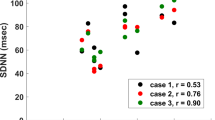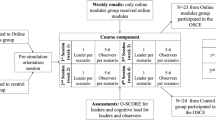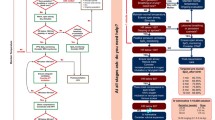Abstract
In general, researchers attempt to quantify cognitive load using physiologic and psychometric measures. Although the construct measured by both of these metrics is thought to represent overall cognitive load, there is a paucity of studies that compares these techniques to one another. The authors compared data obtained from one physiologic tool (pupillometry) to one psychometric tool (Paas scale) to explore whether they actually measured the construct of cognitive load as purported. Thirty-two participants with a range of resuscitation medicine experience and expertise completed resuscitation-medicine based multiple-choice-questions as well as arithmetic questions. Cognitive load, as measured by both tools, was found to be higher for the more difficult questions as well as for questions that were answered incorrectly (p < 0.001). The group with the least medical experience had higher cognitive load than both the intermediate and experienced groups when answering domain-specific questions (p = 0.023 and p = 0.003 respectively for the physiologic tool; p = 0.006 and p < 0.001 respectively for the psychometric tool). There was a strong positive correlation (Spearman’s ρ = 0.827, p < 0.001 for arithmetic questions; Spearman’s ρ = 0.606, p < 0.001 for medical questions) between the two cognitive load measurement tools. These findings support the validity argument that both physiologic and psychometric metrics measure the construct of cognitive load.

Similar content being viewed by others
References
Ayres, P. (2006). Using subjective measures to detect variations of intrinsic cognitive load within problems. Learning and Instruction, 16(5), 389–400.
Beatty, J. (1982). Task-evoked pupillary responses, processing load, and the structure of processing resources. Psychological Bulletin, 91(2), 276–292.
Brunken, R., Plass, J. L., & Leutner, D. (2003). Direct measurement of cognitive load in multimedia learning. Educational Psychologist, 38(1), 53–61.
Cohen, J. (1988). Statistical power analysis for the behavioral sciences (2nd ed.). Hillsdale, NJ: L: Erlbaum.
Cook, D. A. (2015). Much ado about differences: Why expert-novice comparisons add little to the validity argument. Advances in Health Sciences Education, 20(3), 829–834.
Cook, D. A., & Beckman, T. J. (2006). Current concepts in validity and reliability for psychometric instruments: Theory and application. The American Journal of Medicine, 119(2), 166.e7–166.e16.
De Jong, T. (2010). Cognitive load theory, educational research, and instructional design: Some food for thought. Instructional Science, 38(2), 105–134.
Downing, S. M. (2003). Validity: On the meaningful interpretation of assessment data. Medical Education, 37(9), 830–837.
Ericsson, K. A., & Kintsch, W. (1995). Long-term working memory. Psychological Review, 102(2), 211.
Ericsson, K. A., Prietula, M. J., & Cokely, E. T. (2007). The making of an expert. Harvard Business Review, 85(7/8), 114.
Gegenfurtner, A., Kok, E., Van Geel, K., De Bruin, A., Jarodzka, H., Szulewski, A., & Van Merriënboer, J. J. G. (in press). The challenges of studying visual expertise in medical image diagnosis. Medical Education.
Gegenfurtner, A., Lehtinen, E., & Säljö, R. (2011). Expertise differences in the comprehension of visualizations: A meta-analysis of eye-tracking research in professional domains. Educational Psychology Review, 23(4), 523–552.
Gegenfurtner, A., & Seppänen, M. (2013). Transfer of expertise: An eye tracking and think aloud study using dynamic medical visualizations. Computers and Education, 63, 393–403.
Gegenfurtner, A., Siewiorek, A., Lehtinen, E., & Säljö, R. (2013). Assessing the quality of expertise differences in the comprehension of medical visualizations. Vocations and Learning, 6(1), 37–54.
Gegenfurtner, A., & Szulewski, A. (2016). Visual expertise and the Quiet Eye in sports – comment on Vickers. Current Issues in Sport Science, 1, 108. doi:10.15203/CISS_2016.108.
Hess, E. H. (1965). Attitude and pupil size. Scientific American, 212, 46–54.
Hess, E. H., & Polt, J. M. (1964). Pupil size in relation to mental activity during simple problem-solving. Science, 143(3611), 1190–1192.
Kahneman, D., & Beatty, J. (1966). Pupil diameter and load on memory. Science, 154(3756), 1583–1585.
Klingner, J., Kumar, R., & Hanrahan, P. (2008). Measuring the task-evoked pupillary response with a remote eye tracker. Paper presented at the Proceedings of the 2008 symposium on Eye tracking research and applications.
Klingner, J., Tversky, B., & Hanrahan, P. (2011). Effects of visual and verbal presentation on cognitive load in vigilance, memory, and arithmetic tasks. Psychophysiology, 48(3), 323–332.
Kok, E. M., Bruin, A. B., Robben, S. G., & Merriënboer, J. J. (2012). Looking in the same manner but seeing it differently: Bottom-up and expertise effects in radiology. Applied Cognitive Psychology, 26(6), 854–862.
Laeng, B., Sirois, S., & Gredebäck, G. (2012). Pupillometry a window to the preconscious? Perspectives on Psychological Science, 7(1), 18–27.
Laxmisan, A., Hakimzada, F., Sayan, O. R., Green, R. A., Zhang, J., & Patel, V. L. (2007). The multitasking clinician: Decision-making and cognitive demand during and after team handoffs in emergency care. International Journal of Medical Informatics, 76(11), 801–811.
Leppink, J., Paas, F., van Gog, T., van der Vleuten, C. P., & van Merriënboer, J. J. (2014). Effects of pairs of problems and examples on task performance and different types of cognitive load. Learning and Instruction, 30, 32–42.
Naismith, L. M., & Cavalcanti, R. B. (2015). Validity of cognitive load measures in simulation-based training: A systematic review. Academic Medicine, 90(11), S24–S35.
Naismith, L. M., Cheung, J. J., Ringsted, C., & Cavalcanti, R. B. (2015). Limitations of subjective cognitive load measures in simulation-based procedural training. Medical Education, 49(8), 805–814.
Norman, G. (2005). Research in clinical reasoning: Past history and current trends. Medical Education, 39(4), 418–427.
Paas, F. G. (1992). Training strategies for attaining transfer of problem-solving skill in statistics: A cognitive-load approach. Journal of Educational Psychology, 84(4), 429.
Paas, F., Tuovinen, J. E., Tabbers, H., & Van Gerven, P. W. (2003). Cognitive load measurement as a means to advance cognitive load theory. Educational Psychologist, 38(1), 63–71.
Perry, S. J., Wears, R. L., Croskerry, P., & Shapiro, M. J. (2013). Process Improvement and Patient Safety. In J. Marx, R. Walls & R. Hockberger (Eds.), Rosen's Emergency Medicine - Concepts and Clinical Practice (8 Edn., Vol. 2, pp. 2505–2511). Philadelphia: Elsevier Health Sciences.
Schubert, C. C., Denmark, T. K., Crandall, B., Grome, A., & Pappas, J. (2013). Characterizing novice-expert differences in macrocognition: An exploratory study of cognitive work in the emergency department. Annals of Emergency Medicine, 61(1), 96–109.
Sweller, J. (2010). Element interactivity and intrinsic, extraneous, and germane cognitive load. Educational Psychology Review, 22(2), 123–138.
Sweller, J., Van Merrienboer, J. J. G., & Paas, F. (1998). Cognitive architecture and instructional design. Educational Psychology Review, 10(3), 251–296.
Szulewski, A., Fernando, S. M., Baylis, J., & Howes, D. (2014). Increasing pupil size is associated with increasing cognitive processing demands: A pilot study using a mobile eye-tracking device. Open Journal of Emergency Medicine, 2(1), 8–11.
Szulewski, A., Roth, N., & Howes, D. (2015). The use of task-evoked pupillary response as an objective measure of cognitive load in novices and trained physicians: A new tool for the assessment of expertise. Academic Medicine, 90(7), 981–987.
Tuovinen, J., & Paas, F. (2004). Exploring multidimensional approaches to the efficiency of instructional conditions. Instructional Science, 32(1–2), 133–152. doi:10.1023/B:TRUC.0000021813.24669.62.
Young, J. Q., Van Merrienboer, J., Durning, S., & Ten Cate, O. (2014). Cognitive load theory: Implications for medical education: AMEE guide no. 86. Medical Teacher, 36(5), 371–384.
Acknowledgments
The authors would like to thank Wilma Hopman for assistance with statistical analysis, Bence Linder for development and implementation of the algorithm to smooth the raw pupillometry data and to calculate peak pupillary size, as well as Dr. Jimmie Leppink for advice about experimental design. The authors would also like to acknowledge the Kingston Resuscitation Institute for providing access to the pupillometry device and research assistants.
Author information
Authors and Affiliations
Corresponding author
Appendices
Appendix 1
Psychometric survey used in the study, adapted from Paas (1992).

Appendix 2
Example of raw pupillometry data obtained from one experienced participant for one medical question. The first arrow represents the time the question appeared on the screen. The second arrow represents the point at which the participant verbalized his answer. As the participant experiences increasing cognitive load during the thought process, the pupil diameter increases in size. When the participant verbalizes the answer to the question, pupil size decreases again. The quantitative cognitive load measurement used in the pupillometry arm of this study can be conceptualized as the area under the curve between these two arrows (referred to as pupillary change index in this manuscript).

Appendix 3
Data distribution for Paas and Pupillary Change Index scales:
Paas | PCI | |
|---|---|---|
Valid data points | 232 | 222 |
Missing data points | 0 | 10 |
Minimum value | 1 | 2.9 |
Maximum value | 9 | 597.2 |
Mean | 4.7 | 92.7 |
Standard deviation | 1.9 | 95.5 |
25th percentile | 3 | 27.7 |
Median | 5 | 59.4 |
75th percentile | 6 | 124.2 |
Boxplots of the data distribution of the Paas and Pupillary Change Index scales showing outliers:

Rights and permissions
About this article
Cite this article
Szulewski, A., Gegenfurtner, A., Howes, D.W. et al. Measuring physician cognitive load: validity evidence for a physiologic and a psychometric tool. Adv in Health Sci Educ 22, 951–968 (2017). https://doi.org/10.1007/s10459-016-9725-2
Received:
Accepted:
Published:
Issue Date:
DOI: https://doi.org/10.1007/s10459-016-9725-2




